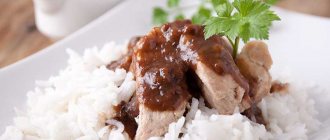Varieties of Japanese sauces
Sauces of Japanese cuisine are divided into simple and complex.
Simple ones are one-component flavoring additives to a dish: wasabi, pickled ginger, soy sauce. The peculiarity is that such additives are served in ready-made form, that is, the product (soybeans, wasabi plant root, ginger root) is initially processed in such a way that the result is a self-sufficient flavor additive.
Complex sauces often contain several components. Preparing such sauces is much more complicated and takes longer than simple ones.
Complex sauces include such sauces as unagi, teriyaki, kimchi, spicy, and nut.
Let's look at the main types of sauces in Japanese cuisine, their compositions and features of use.
Soy sauce
It is impossible to imagine sushi, or Japanese cuisine in general, without the salty and spicy taste of this sauce. Soy sauce in its familiar form appeared in the 17th-19th centuries, during the formation of Japanese cooking, and the first recorded recipe dates back to the same period.
Initially, salty gravy was used for hot appetizers and soups. Today, soy sauce is the main spice for most Asian dishes and an excellent alternative to salt.
Soy sauce can be light (for marinades) or dark (as a dressing); it is served with ready-made dishes in a separate sauce boat.
It is impossible to prepare soy sauce at home: the technology for its production is complex and is based on long-term fermentation of soybeans and wheat in wort. And the unique taste of soy sauce is given by a starter culture in the form of a Koji fungus.
Subsequently, the fermented mass is passed through a press to remove solid waste and pasteurized. Filtration and bottling are the final stages of the manufacturing process.
You can find a ready-made version of soy sauce in any store, but almost every ready-made sauce contains flavor enhancers, flavorings, dyes, thickeners, and preservatives.
High-quality sauces will not contain the components monosodium glutamate, sodium benzoate, potassium sorbate, or citric acid.
Georgian cuisine: walnut bazhe sauce
step by step recipe with photos
Ingredients for Bazhe sauce:
- 400 g walnuts,
- 3 cloves of garlic,
- salt,
- 1 tsp dried blue fenugreek (utskho suneli),
- 1 tsp dried coriander,
- 1 tsp dried red pepper (to taste)
- 1 tsp Imeretian saffron
Remove cooked chicken from oven. Pour the Baje sauce over the chicken and serve immediately. Food: The meal is usually eaten with bread. Baje sauce can also be eaten with Gomi. Gomi is a popular dish from the Samegrelo region, made from coarse cornmeal and topped with strips of cheese and Sulguni butter.
Ingredients for Bazhe sauce
Georgia's unique cuisine is a gourmet treat for every visitor, from vegetarian dishes to sumptuous feasts made from secret spices and rare ingredients, Georgian cuisine offers something for everyone. Rich, tasty, savory, strikingly original and very country-specific, Georgian cuisine is a natural extension of the fertile, mineral-rich landscape fed by the clear waters of the Caucasus Mountains. The kitchen offers a variety of dishes, high in herbs and spices, a variety of vegetarian dishes in addition to meat dishes: organic fresh meat dishes such as pork or lamb, chicken or fish dishes, hazelnuts and walnuts, various types of cheese, pickles and spicy condiments, eggplant, plums, corn, pomegranates, beans, wild herbs, coriander, onions, hot peppers, mint, basil, a love of garlic and much, much more fill homes and restaurants across the country.
Nut/sesame sauce
Walnut or, as it is often called, sesame sauce has a sour-salty taste due to a mixture of rice vinegar and soy sauce. The consistency is similar to butter cream. Corn or wheat flour helps to achieve this look and delicate structure.
The sauce contains:
- sesame;
- soya beans;
- wheat and corn;
- eggs and sugar;
- shiitake mushrooms;
Sometimes garlic is added to sesame sauce for spiciness.
The right combination of ingredients produces a flavorful salty-sour sauce with nutty notes, which is ideal for seafood rolls.
Unagi sauce
Unagi sauce is a traditional flavoring agent in Japanese cuisine. Prepared with soy sauce. Served not only with sushi, but also with any dishes with smoked eel. This dressing has a pronounced salty-smoky taste and a slightly sweet aftertaste.
Unagi sauce is dark in color and thick in consistency. The ingredients give the sauce a characteristic fishy smell and spicy taste.
The composition of unagi sauce in the classic version includes:
- dry white wine;
- soy sauce;
- mirin (cook's rice wine, essentially sake with low alcohol content);
- sugar or powdered sugar;
- fish broth or Hondashi seasoning (similar to broth in granules).
Wine, mirin and soy sauce are taken in proportions of 1:1:1, broth (seasoning) is added and boiled for about 2 hours until the mixture thickens and acquires a caramel shine, then sugar is added and cooled.
How to prepare Georgian sauce Bazhe
1. Grind the walnuts (you can use a blender or meat grinder) and crush the garlic separately.
2. The next step is the most difficult, you need to grate the nuts passed through the meat grinder, pressing on them with the back of a spoon to extract the walnut oil. The oil is later used in the bazhe sauce: the finished dish is added. However, you can skip this step.
3. Add chopped garlic, spices and salt to a bowl with walnuts.
4. Pour 50 ml of boiled, cooled water into the mixture and mix and mash with a fork.
5. Continue adding water, constantly stirring and grinding, until the sauce looks approximately like the photo. like thin sour cream.
[/two_third_last]
Bazhe can be cooked in chicken broth, or add a tablespoon of wine or apple cider vinegar or lemon juice at the very end.
Bazhe can be served with fried fish, tobacco chicken or turkey prepared for the New Year's table.
Tags: fasting dish, vegetarian dish, Georgian cuisine, chicken, sauce
For the New Year's table: French-style turkey in white wine
Previous post
There's no such thing as too much pizza!
Next entry
Teriyaki sauce
Teriyaki sauce is used not only when serving sushi, rolls and other Japanese dishes. Teriyaki means "sugar shine" and "fry" in Japanese, and indeed it is often used as a marinade for grilled meats and fish.
Dishes prepared with the addition of teriyaki have a rich, spicy, smoky taste and a sweetish aftertaste.
This classic Japanese sauce is made from soy or fish sauces, to which vegetables are added: ginger, garlic and others.
Pineapple juice, starch, and sesame seeds can also be added to teriyaki.
Historical reference
The history of sushi began in the rice fields of Asia, where fish was “canned” with rice vinegar, salt and rice, after which the rice was removed and the fish was served. Today, fish preserved in this way is known as “narezushi”, and this dish originated in the Yayoi period. During the Muromachi period, the Japanese began mixing rice and fish into a single dish, and during the Edo period they began using vinegar rather than pickled rice. Nowadays, lumpy rice soaked in vinegar and topped with pieces of fish is known as sushi.
In modern Japanese cuisine, there are many varieties of dishes prepared with rice, vinegar and nori sheets: rolls, maki, gunkan, etc. The taste of a dish depends not only on the ingredients included in it, but also on the sauce with which these dishes are served, and which is added to sushi as one of the components.
We offer several interesting recipes that will not leave even the most devoted fans of Japanese cuisine indifferent.
Spicy sauce
In Japanese cuisine, spicy sauce is used to add a spicy taste to dishes and as an alternative to soy sauce.
“Spicy” is served not only with baked rolls, but also as a dressing for salads, marinades for seafood and meat.
“Spicy” is prepared on the basis of kimchi paste and Japanese kuli mayonnaise. You can also find soy sauce and tobiko caviar in the composition.
Onions, garlic and red pepper are often added to the sauce to add a spicy taste.
Georgian nut sauce
Compound:
- walnut kernels – 0.25 kg;
- pomegranate juice – 125 ml;
- water – 150 ml;
- garlic – 4 cloves;
- fresh cilantro – 30 g;
- ground red pepper – 5 g;
- hops-suneli – 5 g;
- Imeretian saffron – a pinch;
- salt - to taste.
Cooking method:
- Remove the nuts from the shell. Sort through, removing films. If you find any shriveled or moldy nuts, you will have to throw them away.
- Lightly fry the nuts in a dry frying pan, cut or break into small pieces.
- Together with salt and spices, place the nuts in a mortar and pound well.
- Wash, dry, finely chop the cilantro with a knife.
- Pass the garlic through a press.
- Dilute pomegranate juice with warm boiled water.
- Dilute the nut butter with the resulting mixture. Add garlic and herbs to it, mix well.
Kimchi sauce
Kimchi is a thick, spicy vegetable dressing, and also one of the hottest sauces in Japanese cuisine. Kimchi is prepared using ginger, apples and a mixture of spices, always with the addition of red pepper.
Kimchi paste is added to sushi rice and in marinades, and used as a spicy dressing for meat and fish dishes.
To prepare kimchi sauce use:
- ginger;
- garlic.
- apples and tangerines;
- red pepper.
The hot-spicy taste of the sauce is balanced by fruity notes. Sometimes wasabi is also added to kimchi paste.
Total
Each sauce gives the dish a unique flavor. Thanks to sauces, Japanese cuisine tastes sweet and sour, sweet and salty, and even sour and salty. The Japanese are partial to spicy food, and they add this flavor to their dishes using wasabi and kimchi paste.
Japanese dressings and sauces for dishes are not only tasty, but also healthy: hot spices improve digestion and serve as a barrier to infections during the cold season. In addition, Japanese cuisine sauces are low-calorie.
Traditional sauces will help reveal the individuality of Japanese dishes, especially sushi.
Try and choose by adding your favorite dressing to your set of sushi and rolls! sushi Japanese cuisine sauces soy sauce wasabi nut sauce unagi sauce teriyaki spicy kimchi
The charm of Pan-Asian cuisine: Tamaki and Kasho sauces
Connoisseurs of Japanese, Korean, Chinese, Thai, and Vietnamese cuisines ardently support the new global trend - Pan-Asian dishes.
Pan-Asian cuisine is a peculiar mix of traditions of various cuisines of Asian countries. The unique taste of dishes born as a result of mixing various Asian culinary trends has a special flavor and attracts more and more connoisseurs and gourmets. Fans of Japanese and Pan-Asian cuisine who like to cook at home and experiment with seasonings and sauces should pay attention to the Tamaki and Kasho food brands. They are part of a portfolio of the best brands of pan-Asian products produced at their own factories in Russia. Many years of experience (since 2008) is an advantage in producing products that have no analogues on the Russian market. The company is considered a recognized expert in pan-Asian sauces prepared according to traditional Asian recipes. The large production has its own laboratory, equipped with modern high-tech equipment, as well as its own quality service, which guarantees that products comply with international standards.
Tamaki and Kasho brand products are ideal for both beginners and professional cooks.
TAMAKI
The manufacturer positions Tamaki as a bright, daring brand that attracts attention and amazes with the quality and taste of its products. Tamaki is a brand for those who love culinary experiments and love trying something new.
Many connoisseurs of Japanese cuisine love sushi and rolls. Those who cook them at home know how important it is to choose the right seasoning recipe for rice. After honing the recipe and conducting a dozen tastings, the perfect dressing for Tamaki rice was created using natural rice vinegar with a perfectly balanced taste. Just season freshly cooked rice with it and prepare your favorite sushi.
For connoisseurs of spicy-sweet flavors, we recommend trying Tamaki sweet chili sauce with garlic notes. It perfectly complements chicken, shrimp, and seafood dishes. It’s very tasty to dip spring rolls and kebabs in it. Marinate meat, poultry, fish in sweet chili sauce and bake - the dish will turn out tender, with a rich range of flavors and an appetizing crust. Prepare wok dishes of noodles and rice with this sauce - the whole family will be happy.
Tamaki's thick, creamy Sesame sauce will complement many Pan-Asian salads, especially Chuka seaweed salads. Delicate sesame sauce with a pleasant nutty taste is made using Japanese technology and contains a significant amount of sesame seeds. The great taste of the sauce makes it a favorite and desired dressing for many appetizers.
Tamaki white sushi rice is a specially selected variety of rice. It has ideal adhesiveness and structure. It makes wonderful sushi and rolls. The package contains 96% whole grains. The bag has a convenient reusable zip-lock fastener for easy storage of already opened packaging.
Tamaki Natural Rice Vinegar is made from the highest quality raw materials, without the use of acetic acid. Thanks to this, vinegar has a mild taste and a light floral aroma. Tamaki Rice Vinegar is made using an ancient Japanese recipe and aged for three months in barrels to achieve the perfect taste. This vinegar is used for marinating meat, fish and seafood, for preparing salad dressings and sauces for dumplings, wontons and dumplings, for dipping sauces, and for seasoning sushi rice.
KASHO
This name means "master of fire" in Japanese. The brand name is based on the idea of high culinary excellence, so that connoisseurs of Pan-Asian dishes receive guaranteed results with almost no effort during their culinary creativity.
KASHO nut sauce is an ideal salad dressing, as well as a dip for chicken or fish. With it, your dishes will have a bright and unusual taste. The delicate sauce contains pieces of roasted nuts. Many chefs consider its consistency to be ideal. KASHO nut sauce is made using Japanese technology.
It is impossible to imagine Asian dishes without soy sauce. Many gourmets have been searching for years for soy sauce with the perfect taste that they can love immediately and forever. KASHO soy sauce is a product of the highest category. It is the undisputed winner of a number of blind tastings conducted by the manufacturer. The sauce is made using Japanese natural fermentation technology, with a production cycle of 9 months. It has a rich sweet-soy-soy flavor with a slight, subtle spice. Try it - perhaps this is the perfect sauce for you.
The KASHO sauce line includes one of the most popular Japanese sauces in the world - Teriyaki sauce. Classic sweet and salty sauce with notes of ginger and garlic, moderately thick. It is ideal for marinating, frying, baking. Gives an appetizing caramel crust to a baked dish. Fried noodles and rice with additives cooked in a wok with Teriyaki sauce are very tasty.
No gourmet collection would be complete without the traditional Japanese Unagi sauce. It is similar to Teriyaki - also sweetish, quite thick, and with exquisite “smoky” notes. Prepared with naturally fermented soy sauce, it has a pleasant aftertaste and enhances any homemade dish. Very good with fish and poultry, sushi and rolls, wok noodles.
KASHO oyster sauce is a great Asian sauce based on oyster extract. It has a pleasant taste with caramel and salty notes. Makes the taste of dishes brighter, more voluminous, richer. It is great to cook fried dishes in a wok pan (for example, noodles with meat, shrimp, vegetables, mushrooms), marinate poultry and beef in it, prepare salad dressings and sauce for fried rice with various toppings based on it.
KASHO Kimchi sauce will appeal to connoisseurs of fiery and spicy dishes. Seasonings and sauces Kimchi came into Japanese cuisine from Korean - in the Land of Morning Freshness, kimchi is the No. 1 culinary calling card. In Japan, kimchi is also mega-popular and popular among people. And there are about two hundred dishes in Japanese cuisine with Kimchi sauce. KASHO Kimchi sauce has a thick paste-like consistency and contains apple, garlic, ginger and 40% chili pepper. Using Kimchi sauce, you can prepare spicy sauces for rolls, salads, and meat (by mixing Kimchi sauce with soy mayonnaise). The sauce can be used when frying meat to add a spicy, fiery taste with a rich range of aromas, and can also be added to soups.
The Tamaki and KASHO product line will not leave you indifferent. Prepare culinary masterpieces of Japanese and Pan-Asian cuisine every day, easily and with pleasure!











